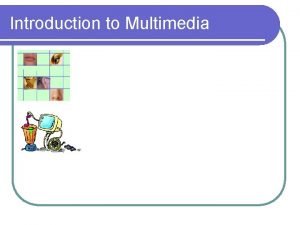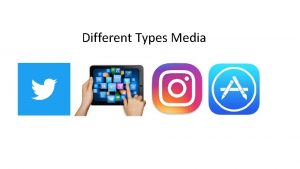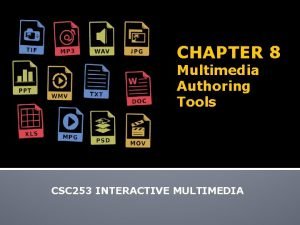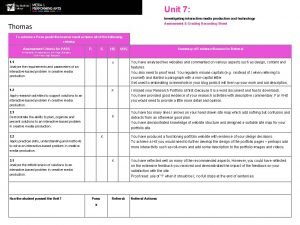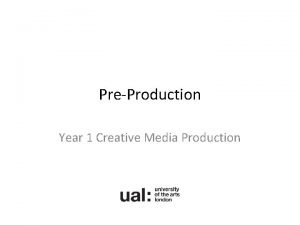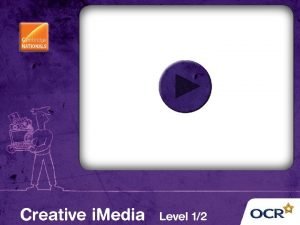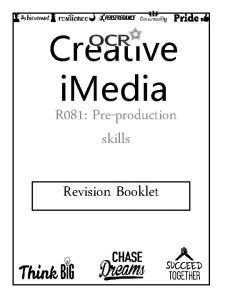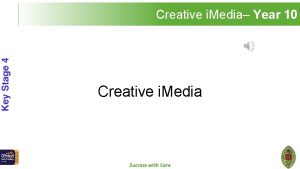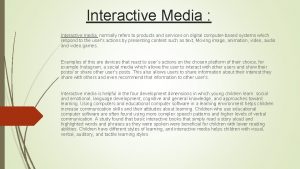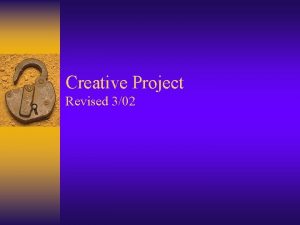Creative i Media R 087 CREATING INTERACTIVE MULTIMEDIA














- Slides: 14

Creative i. Media R 087 CREATING INTERACTIVE MULTIMEDIA PRODUCTS

Scenario for the assignment – Creating Interactive Multimedia Products You are working for your local tourism board and you have been asked to create an interactive multimedia product to provide information on the local area. This product will be used by visitors and tourists to the area. You should include details on the local area, which may include all of the following or focus on one particular aspect of information. You may customise this for a specific target audience which will need to be identified in your planning: • Accommodation and food • Places of interest to visit • Local events: community events/concerts/music festivals, etc. • Shopping and local markets • Libraries, museums and parks • Activities including: cycling, skateboarding, water-skiing and kayaking/canoeing • Other local activities

You will need to: • Identify how the interactive multimedia product will be used in your planning, i. e. on what platform. • Export the multimedia product in a suitable format that retains interactivity to meet the client brief. • Include a range of appropriate assets including video, audio and images.

Task 1: Identify interactive multimedia products Learning Outcome (LO) 1 is assessed in this task. The manager of your local tourism board is unsure about what type of product could be produced and has asked you to provide some information about the range of interactive multimedia products available, where they can be used and the hardware and software required. The purpose of interactive multimedia products You need to: • Investigate the types of interactive multimedia products available and where they are used • Identify design principles used with interactive multimedia products • Identify the hardware, software and peripherals required to create and view interactive multimedia products • Identify the different types of connection which can be used to access interactive multimedia products • Explain the limitations of connections, bandwidth and transfer speeds required to access interactive multimedia products • Include suitable file formats for use on different platforms. Make sure you summarise any investigation and research in your own words. Present your evidence in an appropriate way.


Task 2: Plan the interactive multimedia product Learning Outcome (LO) 2 is assessed in this task. Your client and target audience You need to: • Consider the client requirements based on the brief • Identify the target audience, and what they will want from the interactive multimedia product.

Task 2: Plan the interactive multimedia product Learning Outcome (LO) 2 is assessed in this task. Create a work plan You need to: • Produce a work plan for the interactive multimedia product • Identify the resources which will be needed to create the interactive multimedia product. Produce ideas You need to: • Use appropriate planning techniques to identify the assets needed to create the interactive multimedia product • Create visualisation diagrams, identifying design principles to be used for the interactive multimedia product • Plan the structure and navigation of the interactive multimedia product. Legal restrictions The interactive multimedia product will be used in a commercial context. You need to: • Consider any legal issues and restrictions on the assets used, whether sourced or created.



Task 3: Create the interactive multimedia product Parts of Learning Outcome (LO) 2 and Learning Outcome (LO) 3 are assessed in this task. You will need to produce the interactive multimedia product for your local tourism board, using a range of assets, tools and techniques to ensure it is suitable for the brief. Obtain assets for use in the interactive multimedia product You need to: • Create assets to be used in the interactive multimedia product • Source assets to be used in the interactive multimedia product and save in an appropriate format • Re-purpose assets as needed and save using appropriate file and folder names.

Task 3: Create the interactive multimedia product You need to: • Prepare the structure of the interactive multimedia product • Use multimedia authoring software to combine the assets and create the interactive multimedia product • Create the navigation system as planned • Add interactive features to the multimedia product • Save and export the interactive multimedia product in a suitable format that retains interactivity to meet the client brief • Produce and maintain a test plan throughout production. The final product(s) in their intended digital format must be supplied with the portfolio of evidence.


Task 4: Review the interactive multimedia product Learning Outcome (LO) 4 is assessed in this task. Now the interactive multimedia product for your local tourism board has been produced, you need to consider whether you have met all the requirements of the initial brief. You will also need to review the overall quality of the product, and identify any improvements that could be made. Review the interactive multimedia product You need to: • Review the interactive multimedia product • Describe how well it meets the client’s requirements • Explain how and why the interactive multimedia product could be improved • Describe areas for further development giving reasons for your choices. Present your evidence in an appropriate way.

 Cine depune declaratia 087
Cine depune declaratia 087 Multimedia becomes interactive multimedia when
Multimedia becomes interactive multimedia when Linear and nonlinear multimedia
Linear and nonlinear multimedia R087 interactive multimedia products examples
R087 interactive multimedia products examples Example of multimedia product
Example of multimedia product Kinds of multimedia
Kinds of multimedia Esa multimedia.esa.int./multimedia/virtual-tour-iss
Esa multimedia.esa.int./multimedia/virtual-tour-iss Types of interactive media
Types of interactive media Creative brief
Creative brief Authoring tools in multimedia
Authoring tools in multimedia Interactive media unit
Interactive media unit Recce imedia
Recce imedia Creative strategies in social media marketing
Creative strategies in social media marketing Ocr creative media
Ocr creative media Creative i media revision
Creative i media revision




